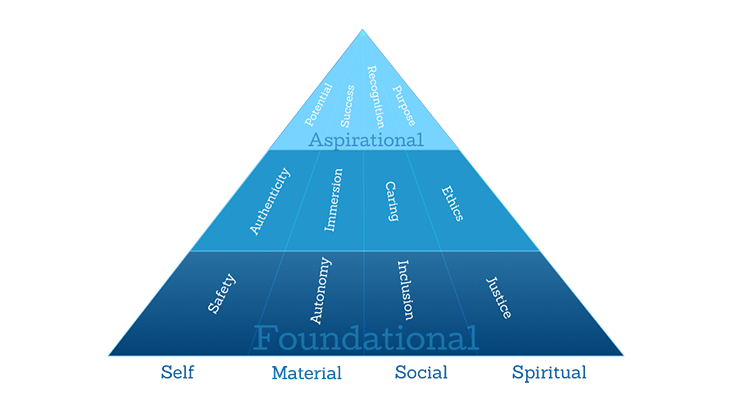The Science Behind AgileBrain
Neuroscience has conclusively demonstrated that the decisions we make are driven first and foremost by our emotions, not by our rational thoughts.

AgileBrain’s fast and fun, image-based assessment provides a quantitative and qualitative picture of your emotional needs and motivations, as well as the language and framework necessary to understand and communicate them.


Images are the best tools for recognizing and expressing emotions and they avoid all the problems of written language (i.e., translation, response style). AgileBrain uses images rather than words, and those images have been rigorously validated to map to 12 specific emotional needs.
AgileBrain reaches emotional depths, mapping emotions across the complete landscape of human needs — the domains of self, material, social and spiritual— and up the hierarchy of needs from foundational to aspirational levels within each.

Leading Indicator Systems’ AgileBrain Model of Emotional Needs

AgileBrain is backed by extensive peer-reviewed research
Theoretical and Empirical Foundations for a Unified Pyramid of Human Motivation
A Time-Constrained, Image-Based method for Assessing Employee Emotions
A Picture’s Worth a Thousand Words


AgileBrain is built on top of a longstanding tradition of using images to conduct research on implicit motives, also known as unconscious emotional needs. Historically, image-based techniques consisted of exposing subjects to a series of standardized images and asking for their interpretations of scenes, which were coded and scored, an entirely qualitative and subjective process. To get around the inherent problems of reliability and validity associated with these kinds of open-ended approaches, we’ve developed sets of images to represent each of the 12 universal emotional needs in the AgileBrain model. And because motivation can stem from either a “pull” (promotion or striving to feel good) or a “push” (prevention or striving to not feel bad) we separately assess both the states you want to feel more and the states you want to feel less.
Unlike earlier image-based approaches such as the Thematic Apperception Test or Rorschach Test, which intentionally used ambiguous images, AgileBrain is designed to reliably measure the presence or absence of defined, universal emotional needs in a clear and unambiguous way.
Using a rapid-exposure, rapid-response protocol, subjects are asked to complete an incomplete sentence by selecting just those images that represent the ways they want to feel. Because this exercise is a simple task that provides “on/off” (selected, not selected) data on a series of images, it avoids many of the psychometric challenges of rating scales and provides a good measure of “gut-level” emotional response
Speed is Key
AgileBrain uses a rapid exposure technique derived from research on the neurology of emotion processing, which finds that we can recognize what we are seeing within about 100 to 200 milliseconds of exposure, which triggers an early emotional response starting at about 500 milliseconds. When it’s been more than 1000 milliseconds since exposure, that’s the brain’s first opportunity to think about what it’s seeing and how it “should” feel. AgileBrain leverages this insight by restricting responses to the period before thinking can occur, which means that responses are primarily emotional in nature, and are free of cognitive filters and distortions, like social desirability.
There’s Nothing so Practical as a Good Theory
AgileBrain images are carefully chosen to represent one, and only one, of the 12 emotional needs specified by the model. Our model of emotional needs is like the periodic table of the elements that you learned about in high school. It has rows and columns which define a matrix. It begins with the assumption that your emotional needs direct your behavior toward goals in four specific areas of life: the self, the material, the social, and the spiritual; these are the four columns. Based on the work of Maslow and others, we also assumed the existence of a hierarchy from foundational to aspirational needs; these are the three rows. Based on Aristotle’s three modes of existence, we defined the need-levels as foundational needs (the most basic being needs), experiential needs (the intermediate doing needs), and aspirational needs (the most advanced having needs). Crossing the four life domains by the three hierarchical levels results in a comprehensive, 12 cell matrix. We know it’s comprehensive because there are no other modes of existence or domains of human activity.
AgileBrain uses a rapid exposure technique derived from research on the neurology of emotion processing, which finds that we can recognize what we are seeing within about 100 to 200 milliseconds of exposure, which triggers an early emotional response starting at about 500 milliseconds. When it’s been more than 1000 milliseconds since exposure, that’s the brain’s first opportunity to think about what it’s seeing and how it “should” feel. AgileBrain leverages this insight by restricting responses to the period before thinking can occur, which means that responses are primarily emotional in nature, and are free of cognitive filters and distortions, like social desirability.
Speed is Key
Trust But Verify
We are obsessive about testing everything about our model, our method, and what it can apply to. That’s why we conduct large scale, nationally-representative research studies at least twice a year to check the validity and reliability of AgileBrain on multiple samples. We’ve found that AgileBrain consistently outperforms traditional survey measures when predicting a whole host of different key outcomes including job retention vs. attrition, employee engagement vs. disengagement, employee well-being, resilience, and even vulnerability to addiction. AgileBrain doesn’t just outperform other measures, it multiplies the amount of variance explained by 2 to 8 times!
There’s Nothing
so Practical as a Good Theory
AgileBrain images are carefully chosen to represent one, and only one, of the 12 emotional needs specified by the model. Our model of emotional needs is like the periodic table of the elements that you learned about in high school. It has rows and columns which define a matrix. It begins with the assumption that your emotional needs direct your behavior toward goals in four specific areas of life: the self, the material, the social, and the spiritual; these are the four columns. Based on the work of Maslow and others, we also assumed the existence of a hierarchy from foundational to aspirational needs; these are the three rows. Based on Aristotle’s three modes of existence, we defined the need-levels as foundational needs (the most basic being needs), experiential needs (the intermediate doing needs), and aspirational needs (the most advanced having needs). Crossing the four life domains by the three hierarchical levels results in a comprehensive, 12 cell matrix. We know it’s comprehensive because there are no other modes of existence or domains of human activity.
We are obsessive about testing everything about our model, our method, and what it can apply to. That’s why we conduct large scale, nationally-representative research studies at least twice a year to check the validity and reliability of AgileBrain on multiple samples. We’ve found that AgileBrain consistently outperforms traditional survey measures when predicting a whole host of different key outcomes including job retention vs. attrition, employee engagement vs. disengagement, employee well-being, resilience, and even vulnerability to addiction. AgileBrain doesn’t just outperform other measures, it multiplies the amount of variance explained by 2 to 8 times!
Trust But Verify
AgileBrain turbo-charges traditional surveys
AgileBrain is able to more than DOUBLE the accuracy of traditional surveys! We agree that traditional surveys are good, but when 90% of emotional energies can’t be measured with traditional methods, adding AgileBrain to a traditional survey makes your results much more accurate and very much more predictive.

The Team behind AgileBrain

J.D. Pincus
Chief Innovation Officer
Published Research
- The Structure of Human Motivation
- Theoretical and Empirical Foundations for a Unified Pyramid of Human Motivation
- Well-being as Need Fulfillment: Implications for Theory, Methods, and Practice
- Employee Engagement as Human Motivation: Implications for Theory, Methods, and Practice
- Organizational Culture as a Need Fulfillment System
- Values as Motives: Implications for theory, methods, and practice
- A Time-Constrained, Image-Based method for Assessing Employee Emotions

Bill Nolen
Chief Scientist
William Nolen, PhD oversees all assessment design and development activities at Leading Indicator Systems (d/b/a AgileBrain) and has partnered with JD to oversee all of the AgileBrain validation studies and predictive modeling work.
Bill was a founding partner of LIS and previously worked with Apogee Development and Spectrum Training developing a range of testing and product support materials. He loves to talk about his work on the original Apple Macintosh, particularly noting that Bill was wearing a black turtleneck when Steve Jobs was still sporting a bow tie.
Bill received all three degrees from Boston University, including his doctorate in Psychometrics. He also taught in the Arts & Sciences, Education and Sargent College at BU and in the Psychology Department at Brandeis University.


